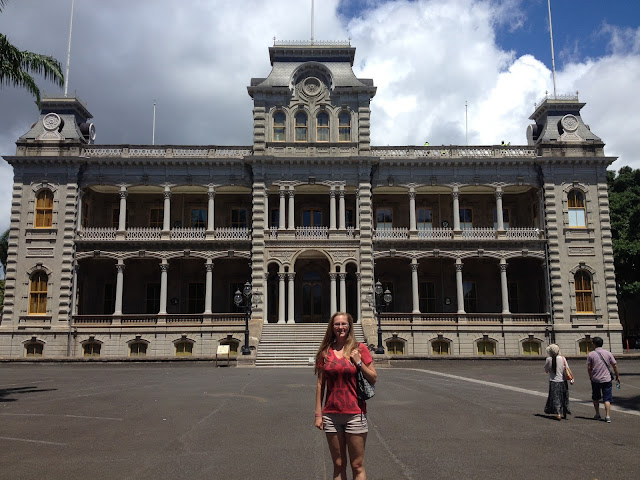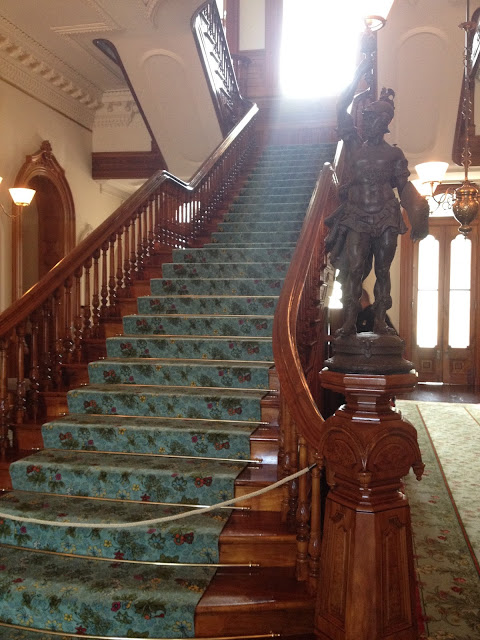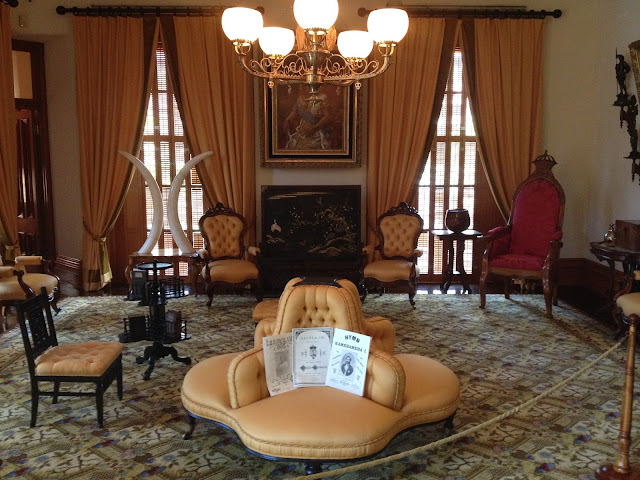Iolani Palace on Oahu
The Iolani Palace is not an old palace by any means, built in the late nineteenth century. It is an important place though, and is a national historic landmark. The Iolani Palace serves as a reminder of how some conniving individuals stripped
Hawaii of its leaders, assimilated it into US culture, and later made it a state. What's past is past, and the US cannot right the wrongs it conducted in the past of the native peoples it over ran (no one alive today was around when the US did its worst to the Native Americans and Hawaiians), but it can commemorate them. The Iolani Palace Museum commemorates the peoples of
Hawaii and serves as a reminder to respect other cultures and sovereign states, something we still need a reminder of.
 |
Standing in front of Iolani Palace in Honolulu on Oahu.
|
When we visited Iolani Palace as part of our trip to
Hawaii, we were given two options to tour the interior. The first option was a guided tour for $22 and the second option was a self-led audio tour for $15. We chose the audio tour since more slots were available and we could get into the palace sooner. Only a certain number of visitors are allowed into the palace for any period of time. Audio tours are allowed in every ten minutes, and we had to wait approximate an hour before we could pick up our audio players, shoe covers (to protect the carpet), and head inside.
 |
| David modeling the audio player in the throne room. |
By the time Iolani Palace was constructed
Hawaii was already well on its way into assimilation with western culture. King David Kalakaua was the first of the Hawaiian monarchs to travel the world, and after seeing how monarchs of Europe ruled from vast palaces he decided
Hawaii needed a palace of its own, from which he could rule is island kingdom. He ordered a palace be built on the lands of the previous rulers the Kamehameha line where a more humble structure used by previous monarchs lay in disrepair. The new palace was built in the Victorian style with dark woods, deep colors, and artistically cluttered rooms. King David Kalakaua was very forward looking in his own right, ensuring the palace was fully wired for electricity and a telephone, things not even the White House had at the time. Unfortunatly King David Kalakaua did not have the forethought to not sign the Bayonet Constitution forced on him by American and European businessmen, which stripped Hawaiian royalty and the common people of most of their rights. I realize the king was held at gunpoint, but this one act seeded the end of the Kingdom of
Hawaii.
 |
| The grand staircase which splits part way up into two small staircases. |
The King died not long after of a long-standing illness and his sister Queen Lili'uokalani succeeded him on the throne. The Queen had other ideas about the Bayonet Constitution and tried to reinstate the powers of the royalty and common folk of
Hawaii. This act resulted in her nine month imprisonment in one of the upstairs rooms of Iolani Palace for treason (rolling my eyes so hard). She eventually abdicated her throne in exchange for the freedom of her supports although she spent the rest of her life pleading with the US government to reinstate her power. The US President Grover Cleveland recommended her reinstatement but would not actively participate in aiding the Queen. Another change in US presidents from Grover Cleveland to William McKinley sealed Hawaii's fate as McKinley saw
Hawaii as a launch pad for his war in the Philippines. McKinley set to making
Hawaii a territory. From there is was only a matter of time until
Hawaii became a state.
 |
| One of the Victorian-style sitting rooms of the palace. |

No comments:
Post a Comment